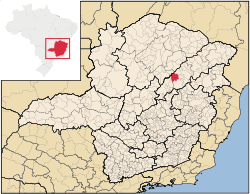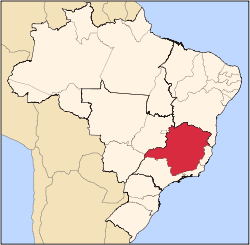Carbonita

Carbonita is a municipality in the northeast of the Brazilian state of Minas Gerais. As of 2007 the population was 10,145 in a total area of 1,454 km². The elevation of the town center is 751 meters. It is part of the IBGE statistical meso-region of Jequitinhonha and the micro-region of Capelinha. It became a municipality in 1963.
The economy is based on cattle raising and agriculture, with the main crops being coffee, sugarcane, and corn. There are extensive plantations of eucalyptus trees for charcoal production. In 2005 there were 629 rural producers but only 13 tractors. As of 2005 there was one hospital with 22 beds and 6 public health clinics. Educational needs were met by 7 primary schools and 1 middle school. There were 779 automobiles in 2006, giving a ratio of 12 inhabitants per automobile (there were 902 motorcycles). There was one bank in 2007.[1]
Neighboring municipalities are: Turmalina, Veredinha, Itamarandiba, Diamantina, Senador Modestino Gonçalves and Bocaiúva. The distance to Belo Horizonte is 421 km.[2] The nearest major population center, Itamarandiba, is 46 km on secondary roads. Highway access from the capital is made by Curvelo and Diamantina, via BR-040, BR-135, BR-259, and BR-367; from João Monlevade, Guanhães, São João Evangelista, Coluna and Itamarandiba, via BR-381, MG-129, BR-120, and BR-451.[3]
Social Indicators
Carbonita is ranked low on the MHDI and was one of the poorest municipalities in the state and in the country in 2000.
- MHDI: .679 (2000)
- State ranking: 639 out of 853 municipalities
- National ranking: 3,313 out of 5,138 municipalities in 2000
- Life expectancy: 67
- Literacy rate: 74
- Combined primary, secondary and tertiary gross enrolment ratio: .827
- Per capita income (monthly): R$112.00[4]
- Urbanization rate: 62.03 (national rate was 81.25)
- Percentage of urban residences connected to sewage system: 72.20 (national rate was 69.52)
- Infant mortality rate: 15.38 (the national average was 18.91).[5]
The above figures can be compared with those of Poços de Caldas, which had an MHDI of .841, the highest in the state of Minas Gerais. The highest in the country was São Caetano do Sul in the state of São Paulo with an MHDI of .919. The lowest was Manari in the state of Pernambuco with an MHDI of .467 out of a total of 5504 municipalities in the country as of 2004.[4]
See also
References
- ↑ IBGE Archived June 11, 2008, at the Wayback Machine.
- ↑ Distancias Minas Gerais
- ↑ Citybrazil
- 1 2 Frigoletto
- ↑ Indicadores de Saúde
Coordinates: 17°31′37″S 43°00′57″W / 17.52694°S 43.01583°W
